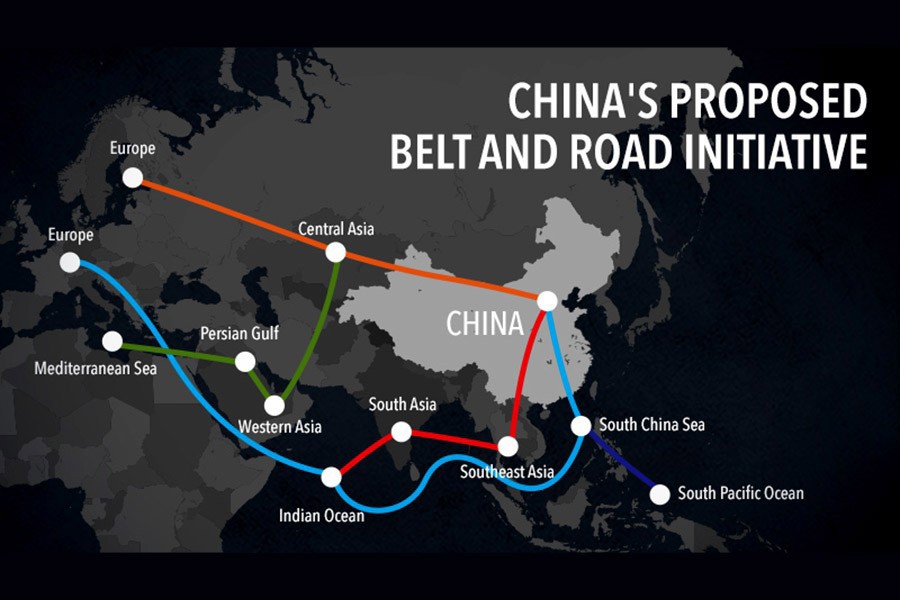The Asia Pacific region appears to be enthralled by China's Belt and Road Initiative (BRI) which is basically aimed at developing infrastructure in the participating countries. According to Eric Brown, Research analyst of the Geopolitical Economic Risk, Belt and Road Initiative promises to link China to both neighbouring and distant regions along its southern and western frontiers through a massive infrastructure investment project, including roads, rail lines, ports, energy pipelines and digital networks. BRI promises to spend one trillion dollars which is several times larger than the Marshall Plan undertaken for the rejuvenation of the European economy. In total, the BRI incorporates more than 60 countries (figures vary), affects nearly 62 per cent of the world's population and includes more than 30 per cent of global gross domestic product. Yet despite its impressive metrics, the project still satisfies only a fraction of the larger infrastructure demand in the region. The Asian Development Bank (ADB) estimates that the continent will require more than $26 trillion of investment between 2016 and 2030.
The international community is aware of the trade tussle between the USA and China that may trigger a global recession. That aside, BRI may aim to supplant a China-led economic sphere in Eurasia in place of the West-led economic system that continues to rule the world since the Second World War.
Critics opine that the Bretton Woods institutions and allied others have been rule-based and legally enforceable system while China's activities in South China Sea appear to be muscular and has sown disquiet in the adjoining countries who also lay claim on the disputed areas. It is further said that notwithstanding the existing proposal, the specific physical and conceptual margins of the BRI remain ambiguous. There is no clear timeline for completion, and some projects that began prior to the official launch date are included retroactively. Physical infrastructure projects are complimented with intangibles like trade accords, cultural exchanges, tourism and educational connections. In addition to transportation networks and energy systems, BRI's infrastructure portfolio has grown to include electronic, space, and polar elements. Besides, little progress has been made except China-Pakistan Economic Corridor (CPEC) which too is not well accepted in Pakistan. Any international initiative to be successful has to be mutually advantageous to the parties concerned. In case of China, BRI would facilitate export of overcapacity of equipment, steel and cement; internalisation of Chinese currency; diversification of energy trade; rural economic development of western and southern regions of China which have not benefited from the phenomenal economic growth of China over decades. BRI is also expected to benefit China in improving foreign market diversification and competitiveness, and most importantly in the emergence of a central political and economic power in Eurasia. Naturally, questions would arise about funding of BRI projects. Asia Infrastructure Investment Bank (AIIB) comprising 93 member states, a competing structure of IBRD and IMF- and New Development Bank (NDP) comprising of BRICS countries are expected to promote sustainable development and infrastructure projects of the member countries.
The US from the very beginning was unhappy over the establishment of AIIB as it did not want another multilateral development bank to appear as a rival to ADB and World Bank. More so, the US and Europe were averse to the authoritarian system of governance of China. The West can take heart from the conclusion of Manixin Pei (China's Trapped Transition) in which Pei theorises that China has reached a phase in which its growth is stagnant. China's political system, Pei argues, cannot be reformed because of its deep-rooted corruption issues and due to the lack of institutional infrastructure to address these issues. Pei labels China's situation as "self-destructive political dynamics inherent in an autocracy caught up in rapid socioeconomic change." Fareed Zakaria refers to the well known belief of scholars that there is a "zone of transition" for authoritarian countries when this happens - between $5,000 to $10,000 per capita GDP (in purchasing power terms). China is at the top of the range, around $10,000. Given China's level of economic, social and educational development, it is highly unusual that China, among Asian nations, has seen almost no movement toward political reform. Manixin Pei attributes this lack of movement to a corrupt yet unified Communist Party which zealously guard against any encroachment on its powers. So, the Hong Kong protests are unlikely to produce an Eastern European deluge leading to the demise of Soviet Union. More likely it may result in another Tiananmen Square. China's open handed policy of giving out loans have given rise to "debt diplomacy" as some of the recipients are now unable to pay back the loans. Examples can be found in the construction of Hambantota port in Sri Lanka, Chinese funded railway link in Laos.
There is now a significant move away from strong endorsement of BRI in the initial period to one of negativity and concern. French President Emmanuel Macron has urged prudence, suggesting during a trip to China that the BRI could make partner countries "vassal state. A report of the Council of Foreign Relations have voiced Indian concern that the BRI is a plan to dominate Asia, warning of what some analysts have called a "String of Pearls" geo-economic strategy whereby China creates unsustainable debt burdens for its Indian Ocean neighbours and potentially takes control of regional choke points. While President Trump may wish to use India as a counterweight to China, countries like Bangladesh have to follow a balanced policy vis-à-vis the two countries. Our natural affinity with India notwithstanding, we have to follow our national interests wherever they lead.
Kazi Anwarul Masud is a former Secretary and ambassador.


